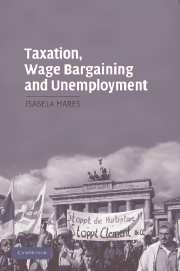Book contents
- Frontmatter
- Contents
- List of Figures and Tables
- List of Abbreviations
- Acknowledgments
- INTRODUCTION: DOES THE WELFARE STATE HURT EMPLOYMENT?
- 1 THE ECONOMIC AND POLITICAL CONSEQUENCES OF WELFARE STATE MATURATION
- 2 A QUANTITATIVE ANALYSIS
- 3 SWEDEN
- 4 GERMANY
- 5 BRITAIN
- CONCLUSION: NEW SOCIAL PACTS IN CONTEMPORARY EUROPE
- References
- Index
- Titles in the series
- References
References
Published online by Cambridge University Press: 06 January 2010
- Frontmatter
- Contents
- List of Figures and Tables
- List of Abbreviations
- Acknowledgments
- INTRODUCTION: DOES THE WELFARE STATE HURT EMPLOYMENT?
- 1 THE ECONOMIC AND POLITICAL CONSEQUENCES OF WELFARE STATE MATURATION
- 2 A QUANTITATIVE ANALYSIS
- 3 SWEDEN
- 4 GERMANY
- 5 BRITAIN
- CONCLUSION: NEW SOCIAL PACTS IN CONTEMPORARY EUROPE
- References
- Index
- Titles in the series
- References
- Type
- Chapter
- Information
- Taxation, Wage Bargaining, and Unemployment , pp. 231 - 252Publisher: Cambridge University PressPrint publication year: 2006



